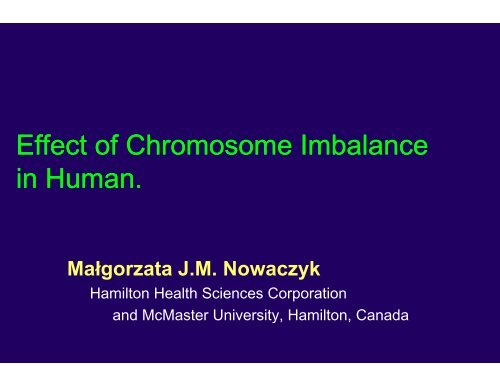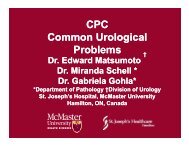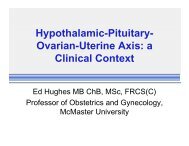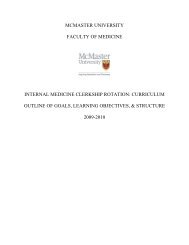Effect of Chromoso ome Imbalance in Human
Effect of Chromoso i Hn uman. in Human. ome Imbalance - Medportal
Effect of Chromoso i Hn uman. in Human. ome Imbalance - Medportal
- No tags were found...
Create successful ePaper yourself
Turn your PDF publications into a flip-book with our unique Google optimized e-Paper software.
<strong>Effect</strong> <strong>of</strong> <strong>Chromoso</strong><br />
<strong>ome</strong> <strong>Imbalance</strong><br />
<strong>in</strong> <strong>Human</strong>.<br />
Małgorzata J.M. Now<br />
waczyk<br />
Hamilton Health Sciences Corporation<br />
and McMaster Unive<br />
ersity, Hamilton, Canada
<strong>Chromoso</strong>mes<br />
• A storage form <strong>of</strong> DNA<br />
• Each consists <strong>of</strong> a s<strong>in</strong>gle, long molecule <strong>of</strong> DNA<br />
• Coiled and condensed<br />
d manyfold (several levels<br />
<strong>of</strong> pack<strong>in</strong>g)<br />
• Genes are arranges along the strand <strong>of</strong> DNA<br />
• Genes – books<br />
• <strong>Chromoso</strong>mes – bookcases<br />
• Gen<strong>ome</strong> – the library
Karyotype<br />
• Arrangement <strong>of</strong> chrom<br />
mos<strong>ome</strong>s <strong>in</strong> pairs.<br />
• Homo sapiens has 23<br />
pairs.<br />
• Two sex chromos<strong>ome</strong><br />
es: XX or XY.<br />
• In each pair there is a maternal and a paternal<br />
chromos<strong>ome</strong>.<br />
• Each abnormal karyotype may have a<br />
characteristics physical manifestation<br />
(phenotype)
Normal Female Karyotype 46,XX
Normal Male Karyotype 46,XY
<strong>Chromoso</strong>me Defe<br />
ects - Def<strong>in</strong>itions<br />
Autos<strong>ome</strong><br />
The non-sex chromos<strong>ome</strong>s,<br />
one <strong>of</strong> the 22 pairs<br />
Sex chromos<strong>ome</strong>s<br />
X or Y chromos<strong>ome</strong><br />
Structure <strong>of</strong> chromos<strong>ome</strong><br />
Metacentric, acrocentric, telocentric<br />
Centr<strong>ome</strong>re, tel<strong>ome</strong>re
Karyotype.<br />
Number – number <strong>of</strong> centr<strong>ome</strong>res: N = 46.<br />
Sex chromos<strong>ome</strong>s, XX or XY.<br />
Other :<br />
t(3;5)(q23.1;q15.2) ;q ) or<br />
rob(13;14)<br />
<strong>in</strong>v(2)(q22.1;p12.1)<br />
1)<br />
der(3)t(8;17)(p11.3;q21.1)mat<br />
del(18)(q2.1q2.23)pat1q2 23)pat<br />
der(3)t(3;5)(q23.1;q15.2)<br />
( )(q ;q )
<strong>Chromoso</strong>me Defe<br />
ects - Def<strong>in</strong>itions<br />
Balanced rearrangement<br />
A structural rearrangement<br />
that results<br />
<strong>in</strong> a normal complement<br />
<strong>of</strong><br />
chromosomal material<br />
Unbalanced rearrangement<br />
A structural rearrangement<br />
that results<br />
<strong>in</strong> additional or miss<strong>in</strong>g<br />
chromosomal material, can be<br />
stable – capable <strong>of</strong> passi<br />
<strong>in</strong>g through<br />
h<br />
meiosis unchanged, or unstable
<strong>Chromoso</strong>me Defe<br />
ects - Def<strong>in</strong>itions<br />
Balanced rearrangemen<br />
ts:<br />
Inversions<br />
Pericentric<br />
Paracentric<br />
Abnormal <strong>of</strong>fspr<strong>in</strong>g with<br />
Duplications or deletions
<strong>Chromoso</strong>me Defe<br />
ects - Def<strong>in</strong>itions<br />
Balanced rearrangements:<br />
Robertsonian translocation<br />
this type <strong>in</strong>volved two<br />
acrocentric chromos<strong>ome</strong>ss<br />
with the loss <strong>of</strong> the short<br />
arms<br />
the resultant normal karyotype<br />
has 45 chromos<strong>ome</strong>s<br />
there is risk <strong>of</strong> unbalanced<br />
<strong>of</strong>fspr<strong>in</strong>g
<strong>Chromoso</strong>me Defe<br />
ects - Def<strong>in</strong>itions<br />
Reciprocal translocationn<br />
results from breakage <strong>of</strong> nonhomologous<br />
chromos<strong>ome</strong> with reciprocal exchange <strong>of</strong> the<br />
broken-<strong>of</strong>f <strong>of</strong>f segments;<br />
usually there is no loss <strong>of</strong><br />
chromosomal material<br />
problems with meiosis and risk <strong>of</strong> unbalanced<br />
<strong>of</strong>fspr<strong>in</strong>g
Reciprocal translocation - balanced
<strong>Chromoso</strong>me Defe<br />
ects - Def<strong>in</strong>itions<br />
Reciprocal translocationn - meiosis
<strong>Chromoso</strong>me Defe<br />
ects - Def<strong>in</strong>itions<br />
Unbalanced rearrangements<br />
Deletions<br />
Duplications<br />
Marker and r<strong>in</strong>g chromo<br />
os<strong>ome</strong>s<br />
Isochromos<strong>ome</strong>s<br />
Dicentric chromos<strong>ome</strong>ss<br />
many <strong>of</strong> these are uns<br />
stable
Reciprocal<br />
translocation<br />
- unbalanced
<strong>Chromoso</strong>me Defec<br />
cts - Incidence<br />
In newborn surveys:<br />
Males 47,XXY<br />
47,XXY<br />
other Y,X<br />
total<br />
Females 45,X<br />
47,XXX<br />
other X<br />
total X<br />
1/1000<br />
1/1000<br />
1/1350<br />
1/360 male births<br />
1/4000<br />
1/900<br />
1/2700<br />
1/580 female births
<strong>Chromoso</strong>me Defec<br />
cts - Incidence<br />
In newborn surveys:<br />
Autosomal aneuploidies<br />
trisomy 21<br />
trisomy 18<br />
trisomy 13<br />
other aneuploidy<br />
total<br />
Structural abnormal<br />
1/830<br />
1/7500<br />
1/22,700<br />
1/34,000<br />
1/700
<strong>Chromoso</strong>me Defec<br />
cts - Incidence<br />
In newborn surveys:<br />
Structural abnormalities<br />
balanced rearrangements<br />
Robertsonian<br />
other<br />
unbalanced<br />
Robertsonian<br />
other<br />
Total<br />
1/1100<br />
1/885<br />
1/13,600<br />
1/1,800<br />
1/1800
<strong>Chromoso</strong>me Defec<br />
cts - Incidence<br />
In newborn surveys:<br />
Total chromosomal abnormalities <strong>in</strong> live births<br />
1/154<br />
Total chromosomal abno<br />
ormalities <strong>in</strong> spontaneous<br />
abortions<br />
40-50%
A baby:<br />
hypotonic, poor feed<strong>in</strong>g<br />
g, unusual-look<strong>in</strong>g<br />
for his ethnic background
Down syndr<strong>ome</strong>: Trisomy 21<br />
Cl<strong>in</strong>ical exam:<br />
hypotonia<br />
epicanthal folds,<br />
s<strong>in</strong>gle palmar creases<br />
nuchal fold thicken<strong>in</strong>g<br />
squa<br />
ared-<strong>of</strong>f ears<br />
flat occiput<br />
Brus<br />
schfield spots<br />
Other: pyloric stenosis, cardiac<br />
defects, dislocated hips<br />
Developmental delay
Down syndr<strong>ome</strong>: Trisomy 21
Down syndr<strong>ome</strong> - <strong>Chromoso</strong>mes<br />
Why test chromos<strong>ome</strong>s?<br />
trisomy 21 – 95%<br />
recurrence risk<br />
depends on maternal age<br />
Robertsonian translocation t( (13;21), t(14;21) – 4%<br />
10-15% if mother a carrier,
Recurrent Pregnanc<br />
cy Losses<br />
I<br />
II<br />
III
Autosomal Recip<br />
procal Translocations<br />
– Familial<br />
Draw a three-generation family tree<br />
Note pregnancy losse<br />
es, stillbirth, neonatal<br />
death, and family members with<br />
developmental dela<br />
ays or congenital<br />
anomalies<br />
Confirm that the cons<br />
sutand does not have<br />
health problems or learn<strong>in</strong>g disabilities
Autosomal Recip<br />
procal Translocations<br />
– Familial<br />
Rough risk assessment based on the family<br />
history and the sizes <strong>of</strong> the chromosomal<br />
framents <strong>in</strong>volved <strong>in</strong><br />
the rearrangement (any<br />
family ascerta<strong>in</strong>ed by the birth <strong>of</strong> a child with<br />
an unbalanced karyotype is at risk for further<br />
<strong>in</strong>cidence, <strong>in</strong> this situation the risk is <strong>of</strong>ten<br />
>1%).
Autosomal Recip<br />
procal Translocations<br />
– Familial<br />
Determ<strong>in</strong>e breakpo<strong>in</strong>ts – risk for viability are the<br />
highest when the breakpo<strong>in</strong>ts are the closest to<br />
tel<strong>ome</strong>res, i.e., with th<br />
he smallest segments.<br />
Determ<strong>in</strong>e whether the product with the smallest<br />
imbalance would be viable (databases, literature<br />
search, etc):<br />
monosomy less likely viable than trisomy<br />
monosomy for whole autos<strong>ome</strong> is not viable<br />
trisomy for only the smallest whole chromos<strong>ome</strong>s<br />
(21, 13, 18) is viable
Case.<br />
27 yo G2P1<br />
• Healthy, one child <strong>in</strong> previous relationship<br />
• Baby:<br />
holoprosencephaly<br />
bilateral cleft lip<br />
sacral agenesis<br />
ambiguous genitaliaa<br />
born at 37/40 and died at 20 m<strong>in</strong>utes <strong>of</strong> age<br />
•FHx:<br />
neonatal death <strong>of</strong> a similarly il l affected father’s sib<br />
work-up (30 years ago):<br />
buccal smear<br />
negative for sex chromat<strong>in</strong><br />
autopsy
Work-up.<br />
Cytogenetic analyses<br />
• Abnormal male karyotype:<br />
• Father:<br />
46,XY,der(7)t(2;7)(p2<br />
,de )(p 3.2;q36.1)<br />
trisomic for a small portion <strong>of</strong> distal 2q<br />
monosomic for a small portion <strong>of</strong> distal 7q<br />
• Mother: 46,XX<br />
46,XY,t(2;7)(p23.2;q36.1)<br />
• Paternal grandmother: 46,XX,t(2;7)(p23.2;q36.1)
Case – cont’d<br />
• Diagnosis known<br />
• Genetic counsell<strong>in</strong>g<br />
risk <strong>of</strong> recurrence<br />
identification <strong>of</strong> other family<br />
members at risk<br />
• Prenatal diagnosis available<br />
CVS or amniocen<br />
ntesis for cytogenetic analysis<br />
• Next pregnancy : CVS 11 weeks --<br />
balanced karyoty<br />
ype 46,XX,t(2;7)(p23.2;q36.1)<br />
2;q36 NOT at risk for anomalies, but reproductive risks<br />
• Healthy baby girl born atterm<br />
term
Trisomy 18
Trisomy 18<br />
Severe IUGR, postnatal t fa<br />
ailure to thrive<br />
Prom<strong>in</strong>ent occiput,<br />
small triangular face<br />
widely spaced nipples<br />
short sternum<br />
rocker bottom feet<br />
Prenatal – choroid plexus<br />
cysts<br />
95% spontaneous abortion<br />
80% are female<br />
Multiple <strong>in</strong>ternal malforma<br />
ations
Trisomy 13
Trisomy 13<br />
Normal <strong>in</strong>trauter<strong>in</strong>e t i growt<br />
th or IUGR<br />
Severe central nervous system malformations<br />
holoprosence<br />
phaly, arh<strong>in</strong>encephaly<br />
Cleft lip and palate<br />
Mirophthalmia, colobomas<br />
Polydactyly,<br />
Rocker bottom feet<br />
20% are a result <strong>of</strong> an unbalanced translocation<br />
Multiple <strong>in</strong>ternal malforma<br />
ations – cardiac, GU,
<strong>Chromoso</strong>mal Im<br />
mbalances –<br />
Aneuploidies.<br />
Deletion or duplications<br />
Miss<strong>in</strong>g or extra chro<br />
mosomal material<br />
Phenotypic effects depend on the type, location<br />
and size <strong>of</strong> imbalan<br />
nce.<br />
Duplications tolerated<br />
better than deletions –<br />
frequently normal phenotype.
<strong>Chromoso</strong>mal Im<br />
mbalances –<br />
“The <strong>Chromoso</strong>mal Phenotype”.<br />
Family history <strong>of</strong> mental<br />
retardation/developmental delay.<br />
Prenatal or postnatal growth retardation.<br />
microcephaly, short<br />
stature<br />
Dysmorphic features.<br />
Congenital malformations.
Contiguous Gene<br />
Syndr<strong>ome</strong>s:<br />
• disorders caused by a<br />
bnormal gene dosage<br />
(duplications, deletions) result<strong>in</strong>g from chromosomal<br />
abnormalities<br />
characteristic cl<strong>in</strong>ical phenotype<br />
Smith-Magenis s, Williams s, VCF<br />
• chromosomal abnorma<br />
ality may be visible ibl with rout<strong>in</strong>e<br />
cytogenetic methods<br />
• <strong>of</strong>ten require special te<br />
echniques (FISH)<br />
• caused by low copy DNA repeats that lead to<br />
rearrangements
Contiguous Gene<br />
Syndr<strong>ome</strong>s:<br />
Williams s.<br />
7q<br />
Miller-Dieker s.<br />
17p13.3<br />
blepharophimosis-ptosisvelocardi<strong>of</strong>acial/DiGeorgee<br />
s 22q11.2<br />
epicanthus <strong>in</strong>versus s.(BPES)<br />
3q22.3q23<br />
DMD/chronic granulomato<br />
ous d/glycerol gy k<strong>in</strong>ase def’y/RP<br />
Xp21<br />
Prader-Willi/Angelman s 15q<br />
Beckwith-Wiedemann s 11p15.5
Blepharophimosis-Ptosis-Epicanthus<br />
Inversus s.
Miller-Dieker syndr<strong>ome</strong>:
Smith-Magenis syndr<strong>ome</strong>:
Smith-Magenis s.<br />
• Smith et al., 1983<br />
Am J Med Genet 24:421-32<br />
• 9 unrelated patients<br />
with characteristic facial<br />
appearance, short<br />
f<strong>in</strong>gers, self-destructive<br />
behaviors, and developmental delay<br />
• growth deficiency and congenital anomalies<br />
• <strong>in</strong>terstitial deletion <strong>of</strong> 17p11.2-12
Duplication 17(p11.2p11.2) Potocki-<br />
Lupski Syndr<strong>ome</strong>.
A<br />
ngelman Syndr<strong>ome</strong><br />
Frequency ~1/15,000<br />
Severe mental handicap<br />
Ataxia<br />
Seizures<br />
Happy appearance<br />
Inap<br />
ppropriate outbursts <strong>of</strong> laughter
Impr<strong>in</strong>t<strong>in</strong>g Syndrom<br />
mes:<br />
• disorders caused by abs<br />
ence <strong>of</strong> genetic material from<br />
one <strong>of</strong> the parents <strong>in</strong> areas <strong>of</strong> the gen<strong>ome</strong> that require<br />
biparental contribution<br />
• may be caused by chromosomal (duplications,<br />
deletions) or molecular abnormalities (impr<strong>in</strong>t<strong>in</strong>g centre<br />
mutations)<br />
characteristic cl<strong>in</strong>ical phenotype<br />
Algelman s., Prade-W<br />
Willi s., Beckwith-Wiedemann s.<br />
• chromosomal abnormality may be visible with rout<strong>in</strong>e<br />
cytogenetic methods
Prader-Willi Syndr<strong>ome</strong><br />
Frequency ~1/15,000<br />
Hyperphagia and obesity<br />
beg<strong>in</strong>n<strong>in</strong>g <strong>in</strong> childhoodd<br />
FTT without special feed<strong>in</strong>g effort<br />
Small hands and feet<br />
Hypotonia <strong>in</strong> newborn period<br />
Almond shaped eyes<br />
Mild to modrate devlopmental<br />
delay
PWS and AS<br />
• Dist<strong>in</strong>ct from each other - not opposites<br />
• Involve impr<strong>in</strong>ted genes <strong>in</strong><br />
not the same genes - they<br />
the same chromosomal region but<br />
are not allelic<br />
• Caused by deficiencies <strong>in</strong> dist<strong>in</strong>ct genes which happen to be<br />
close to each other <strong>in</strong> a chromos<strong>ome</strong> region which tends to get<br />
deleted d as a chunk
Early Investigationss<br />
<strong>Chromoso</strong>me deletions <strong>in</strong> the region <strong>of</strong> 15q11-13 <strong>in</strong> a certa<strong>in</strong><br />
proportion <strong>of</strong> patients with either PWS or AS<br />
How can you have one s<strong>in</strong>gle chromos<strong>ome</strong> error giv<strong>in</strong>g you<br />
two dist<strong>in</strong>ct disorders?<br />
PWS - deletion was always on the paternally contributed copy<br />
<strong>of</strong> chromos<strong>ome</strong> 15<br />
Angelman - deletion always<br />
copy <strong>of</strong> chromos<strong>ome</strong> 15<br />
on the maternally contributed
Beckwith-Wiedemann Syndr<strong>ome</strong><br />
Frequency ~1/15,000<br />
Pre- and postnatal overgrowth<br />
Viscer<strong>ome</strong>galy<br />
Macroglossia<br />
Ear abnormalities<br />
Hemiyperplasia<br />
Increased risk <strong>of</strong> childhood<br />
tumours (7-21%)
Beckwith-Wiedemann Syndr<strong>ome</strong>
Beckwith-Wiedemann Syndr<strong>ome</strong>:<br />
Molecular Mechanisms<br />
An impr<strong>in</strong>ted cluster <strong>of</strong> gene<br />
es at 11p15.<br />
Two doma<strong>in</strong>s <strong>of</strong> impr<strong>in</strong>ted genes; two impr<strong>in</strong>t<strong>in</strong>g centers<br />
<strong>in</strong>clude; at least 12 impr<strong>in</strong>ted genes.<br />
Changes <strong>in</strong> the methylation<br />
<strong>of</strong> the genetic centers are<br />
epigenetic because they do<br />
not <strong>in</strong>volve a change <strong>in</strong> the<br />
nucleotide sequence.<br />
Parent <strong>of</strong> orig<strong>in</strong> changes ca<br />
an be brought about by<br />
microscopic chromosomal rearrangements.





